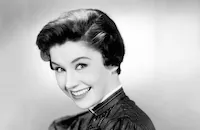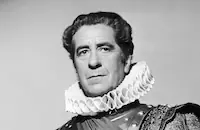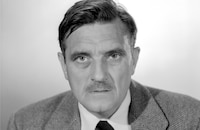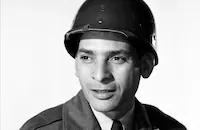Walk the Proud Land
Brief Synopsis
Cast & Crew
Jesse Hibbs
Audie Murphy
Anne Bancroft
Pat Crowley
Charles Drake
Tommy Rall
Film Details
Technical Specs

Synopsis
In the 1870s, John Philip Clum, an Indian agent, arrives in Tucson to take up his new job as adviser to the San Carlos Apache reservation and meets with his superiors, Governor Safford and General Wade. Clum's humanist tendencies disturb the belligerent Wade, who believes that the only way to deal with the Indians is through military might. In response, Clum states that the Department of the Interior currently believes it has a duty to protect the Indian bands that have surrendered and will no longer seek to wipe them out. When Clum arrives at the reservation and sees a group of Apache men being brought back from the work fields in chains, he demands that Captain Larsen, head of the San Carlos cavalry, unchain them. Larsen is angry, but complies, and later, Tianay, an Indian woman in mourning for her husband, thanks Clum for his act of kindness. Later, when Clum hears some braves making war cries, he approaches the men and a scuffle ensues. Chief Eskiminzin arrives and scolds his braves for fighting with the man who set their chief free, and instead of allowing the cavalry to punish them, Clum instructs the chief to punish the braves as he sees fit. Acting on orders from President Ulysses S. Grant, Clum tells Larsen to leave San Carlos, and then instructs the Apaches to set up their own police and judicial system. After the chief chooses Taglito, Alchise and Chato as the new keepers of the peace, Clum returns to his cabin to find that Tianay has moved in with her young son Tono. Clum tells her that he is already engaged to another, but she begs him not to send her back as it will disgrace her in the eyes of the chief. Meanwhile, when food supplies do not arrive from Tucson, Clum agrees to procure guns for the Indians so that they can hunt. Later, the Apache police force bring in two scoundrels, whom Clum had earlier met in Tucson hawking Apache scalps. Clum takes the men into Tucson to be jailed for poaching, but while having a drink with Tom Sweeny, a former Army man from San Carlos, the scoundrels, having been released, show up and a brawl ensues. Afterward, Clum finally succeeds in convincing Sweeny to take a job training the Apache police force. Back at the reservation, Taglito tells Tianay that he wants to marry her and is jealous of Clum. When Taglito's brother decides to shoot at Clum with his newly acquired rifle, however, Taglito shoots him dead, and later, the chief tells Clum that Taglito wishes to make him his blood brother. Tianay tries to convince Clum to have more than one wife, and when Clum, who is weakening, receives a letter from Mary Dennison, his fiancée, he decides that they will marry upon her arrival. Clum invites the governor, the general and other officials to the wedding ceremony, but no one shows up, except Sweeny's Apache police force, who give a gun salute, much to the governor's chagrin. Despite this gaffe, Clum persuades the governor to attend an Apache dance performance that night, as an act of cultural exchange, and the governor agrees, eventually warming to Clum's ways. During the dance, Clum introduces Mary to Tianay and Tono, and Mary is shocked when she discovers that Tianay has been living with her husband. Just then, infamous Apache renegade Geronimo arrives at San Carlos and calls on Taglito and another brave, Santos, to join him. Clum offers the braves the freedom to go, but they decline. Clum then tells Geronimo that he can stay on the reservation, if he follows the rules, and the renegade departs to think about the proposal. Later, Mary tells Tianay to leave the couple's cabin, and Clum scolds her for not being sensitive to the Apache's ways. Tono is sad that Clum will not be his father and convinces a young friend, Pica, to go with him into the wilderness to find Geronimo. Later, Mary encourages her husband to search for the boy, and Tianay and Clum eventually find the children asleep in some bushes. The four then witness Geronimo attacking a wagon train, and the Cavalry rides in. Back at San Carlos, Taglito wants to take the rifles and join Geronimo, but Clum says that they will have to kill him first. Clum announces that he will talk to Geronimo, and after a terrified Mary tries to stop him, Clum, Sweeny and the Apache police head for the wilderness. Clum says that he will deal with Geronimo in the same way that the Bible's Gideon fought his enemy: They will trick Geronimo into thinking that they have more forces than they do by shooting rifles into the air. Geronimo laughs when he hears from his scout that Clum is approaching with only twenty men, but after Clum fails to convince Geronimo to surrender, the remaining men shoot their rifles and the echo scares Geronimo's men, who flee. Clum brings in Geronimo and his men in chains, while the Cavalry returns to San Carlos. When Wade proclaims that he is now in control, Clum quits his job in disgust and disappointment. Taglito and the chief, however, convince Clum not to run away, but to stay and continue to fight for their rights. Even Mary encourages him to carry on his good works. Tono, having given up Geronimo as his hero, wields his toy gun, calling, "I am Mister, I capture my enemies."

Director
Jesse Hibbs
Cast

Audie Murphy

Anne Bancroft

Pat Crowley

Charles Drake

Tommy Rall

Robert Warwick
Jay Silverheels
Eugene Mazzola

Anthony Caruso
Victor Millan
Ainslie Pryor
Eugene Iglesias

Morris Ankrum

Addison Richards

Maurice Jara
Frank Chase
Ed Hinton
Marty Carrizosa
George Keymas
John Pickard
Natividad Vacio
Clem Fuller
William Forrest
Rankin Mansfield
Francis Mcdonald
Paul Mcguire
William O'neal
Jack Lomas
Tyler Mcvey
Jack Mather
Jean Andren
Bernie Gozier
Jerry Eskow
Herold Goodwin
Vi Ingraham
Crew
Phil Bowles
Leslie I. Carey
Ray Decamp
Gil Doud
Bob Forrest
William Fritzsche
Russell A. Gausman
Joseph Gershenson
Alexander Golitzen
Harold Goodwin
Ray Jeffers
Ted Kent
Harold Lipstein
Bill Newberry
Sergei Petschnikoff
Aaron Rosenberg
Jack Sher
Joan St. Oegger
Clifford Stine
Bill Thomas
Sherman Todd
James Welch
Bud Westmore
Frank H. Wilkinson

Videos
Movie Clip


Trailer
Film Details
Technical Specs

Articles
Walk the Proud Land
Murphy's fortunes had been better in the European Theater of Operations than they would be as a Hollywood hopeful. Even with his wartime memoirs, To Hell and Back, charting as a New York Times best seller, Murphy had to make do at first with bit parts in inconsequential features. He played a copy boy in William Castle's minor crime film Texas, Brooklyn & Heaven and a West Point cadet in John Farrow's courtroom drama Beyond Glory (both 1948) before winning his first starring role. His portrayal of an angry juvenile delinquent (more misunderstood than malicious) remanded to a summer camp detention center in Kurt Neumann's Bad Boy (1949) won Murphy a Universal contract. The future cowboy star made his first western, again under the direction of Kurt Neumann, as William "Billy the Kid" Bonney in The Kid from Texas (1950). That same year, he was Jesse James in Kansas Raiders (opposite a young Tony Curtis) and Wild Bunch founder Bill Doolin in The Cimarron Kid (1952) for director Budd Boetticher. Murphy's highest profile role at the time was as the star of John Huston's The Red Badge of Courage (1951). Based on the novel by Stephen Crane, the adaptation fell victim to a regime change at MGM and was recut by studio head Dore Schary while Huston was preparing The African Queen (1951). Even trimmed to 69 minutes (Huston's preferred cut is presumed lost) and rife with studio-imposed continuity errors, the film represented a quantum leap for Audie Murphy in terms of his perception within the film community as a leading man of weight and worth.
Murphy appeared as himself in Universal-International's adaptation of To Hell and Back (1955), a role for which he had suggested Tony Curtis (despite the fact that Curtis had been his rival for the attentions of actress Wanda Hendrix, Murphy's first wife). That film's success allowed Murphy more latitude in choosing roles: as a suspected Yankee spy in Indochina in Joseph Mankiewicz's The Quiet American (1958), as a villainous gunslinger in Jack Arnold's No Name on the Bullet (1959) and as a principled Indian agent in Walk the Proud Land (1956), directed by To Hell and Back helmer Jesse Hibbs. Based on the exploits of John Philip Clum (1851-1932), the Arizona government's advisor to the San Carlos Apache Indian reservation, the film depicts Clum's attempts to deal fairly with the long-abused aboriginals and to bring renegade chieftain Geronimo (Long Ranger costar Jay Silverheels) off the warpath. Despite being nearly a decade older than the 23 year-old Clum was at the time, Murphy proved a good fit for the historical personality, one of the few Wild West figures to be well-regarded by both whites and Native Americans. An associate and friend of Wyatt Earp, the one-time Mayor of Tombstone appears as a supporting character in Gunfight at the OK Corral (1957), Hour of the Gun (1967), Tombstone (1993) and Wyatt Earp (1994), among other films, often played by actors more than twice Clum's actual age.
The Universal-International production had originated with Clum's biography, Apache Agent: The Story of John P. Clum (Houghton-Mifflin, 1936), written by Woodworth Clum from his father's unpublished reminiscences. The studio retained a shortened version of the book's title as the Technicolor/CinemaScope production got underway shortly before Thanksgiving 1955 in and around Tucson, Arizona. Cast opposite Murphy, as John P. Clum's Eastern fiancée and the Apache widow gifted to the Indian agent by a grateful Apache chieftain, were rising starlets Piper Laurie and Anne Bancroft. Bancroft had just come off of the Psychotronic double-header of the 3D circus thriller Gorilla at Large (1954) and the Biblical sub-epic Demetrius and the Gladiators (1954), Delmer Daves' follow-up to The Robe (1953). Signed at 17 by Universal, Piper Laurie had been groomed by the studio for a career as a sexless ingénue but the Detroit-born actress had other ideas. Despite a weekly salary of $2,000, Laurie grew frustrated with eye candy roles in such fluff as Francis Goes to the Races (1951) and Son of Ali Baba (1952) and refused the assignment in Walk the Proud Land, purportedly throwing the Gil Doud-Jack Sher screenplay into her fireplace. While Laurie headed to New York to study with the Actor's Studio, her role was passed to Pat Crowley. Another Hollywood hopeful, David Janssen (who had played a small role in To Hell and Back), tested for a supporting role in the film in October of 1956 but Walk the Proud Land was not among the six features in which he appeared that year.
Audience response was disappointing at the time of the September 1956 opening. As The Red Badge of Courage had suffered at the box office for putting Murphy in the shoes of a timorous wartime virgin, so Walk the Proud Land alienated the actor's fans by depicting him not as a gunfighter but a peaceable humanitarian whose greatest act of courage lies in not fighting. Critical reaction was equally cool, with The New York Times denigrating the "drowsy" script and Murphy's "somnambulant expression of a boyish counselor making his rounds at day camp." Contemporary film scholars have been kinder, recognizing the film's groundbreaking bid to humanize the American Indian.
The project's failure queered the deal for Murphy's dream project, a biopic of frontier painter Charles Marion Russell (1864-1926), but he remained at Universal-International for another decade while accepting the occasional outside assignment. A longtime victim of what is now known as posttraumatic stress disorder, Murphy battled depression and violent outbursts and spent his final years as an advocate for US veterans. While on a business trip in May 1971, Murphy perished along with five other passengers and pilot Herman Butler in the crash of a chartered airplane in the Jefferson National Forest, near the Virginia town of Galax. He was 46 years old.
Producer: Aaron Rosenberg
Director: Jesse Hibbs
Screenplay: Gil Doud, Jack Sher; Woodworth Clum (biography)
Cinematography: Harold Lipstein
Art Direction: Alexander Golitzen, Bill Newberry
Music: William Lava, Hans J. Salter (both uncredited)
Film Editing: Sherman Todd
Cast: Audie Murphy (John Philip Clum), Anne Bancroft (Tianay), Pat Crowley (Mary Dennison), Charles Drake (Tom Sweeny), Tommy Rall (Taglito), Robert Warwick (Chief Eskiminzin), Jay Silverheels (Geronimo), Eugene Mazzola (Tono), Anthony Caruso (Disalin), Victor Millan (Santos), Ainslie Pryor (Capt. Larsen), Eugene Iglesias (Chato), Morris Ankrum (Gen. Wade), Addison Richards (Gov. Safford).
C-89m.
by Richard Harland Smith
Sources:
The Films and Career of Audie Murphy: America's Real Hero by Sue Gossett (Empire Publishing, 1996)
Audie Murphy: Now Showing by Sue Gossett (Empire Publishing, 1996)
Savages and Saints: The Changing Image of American Indians in Westerns by Bob Herzberg (McFarland & Co., 2008)
"Veterans Remember Hero: Actor Audie Murphy was killed in 1971 when an airplane flew into the side of Brush Mountain" by Tim Thornton, The Roanoke Times, November 11, 2004.

Walk the Proud Land
Quotes
Trivia
Notes
This film's working title was Apache Agent. The written prologue states that the story is true and that it began in 1874. The words of the prologue are also spoken, by Woodworth Clum, the son of John Philip Clum and author of the biography on which the film is based. A written epilogue and voice-over narration state: "John Clum spent the rest of his life fighting for the welfare of his Indians, but his dream of self government for them was not realized until long after his death. In November 1955, the United States Government turned the administration of the San Carlos reservation over to the Apaches themselves..." Clum, an Indian agent, was, according to Variety, "the first white man to force the surrender of the notorious Geronimo." Geronimo's final surrender took place on September 3, 1886 to General Nelson Miles.
Piper Laurie was originally cast as "Mary Dennison," but, according to a November 1955 Hollywood Reporter news item, asked to be released from her Universal contract just before filming began. Modern sources state that Laurie left the studio out of frustration with what she considered a lack of substantial roles. According to a Hollywood Reporter news item, location shooting took place in Tucson, AZ. The Hollywood Reporter reviewer praised the picture as being "one of the most interesting stories of the American frontier" in that it is "based on a true story of an important part of U.S. history, the turning point in the treatment of the Indian by the white conqueror."
Other films based on the life of Geronimo include Paramount's 1940 production Geronimo, directed by Paul H. Sloane and starring Preston Foster (see AFI Catalog of Feature Films, 1931-40) and the 1962 United Artists picture Geronimo, directed by Arnold Laven and starring Chuck Connors (see AFI Catalog of Feature Films, 1961-70). In 1993, a television film entitled Geronimo, directed by Roger Young starring Joseph Runningfox, was broadcast on the TNT cable network. That same year, a feature film entitled Geronimo: An American Legend, was released by Columbia Pictures, directed by Walter Hill and starred Wes Studi as Geronimo.















